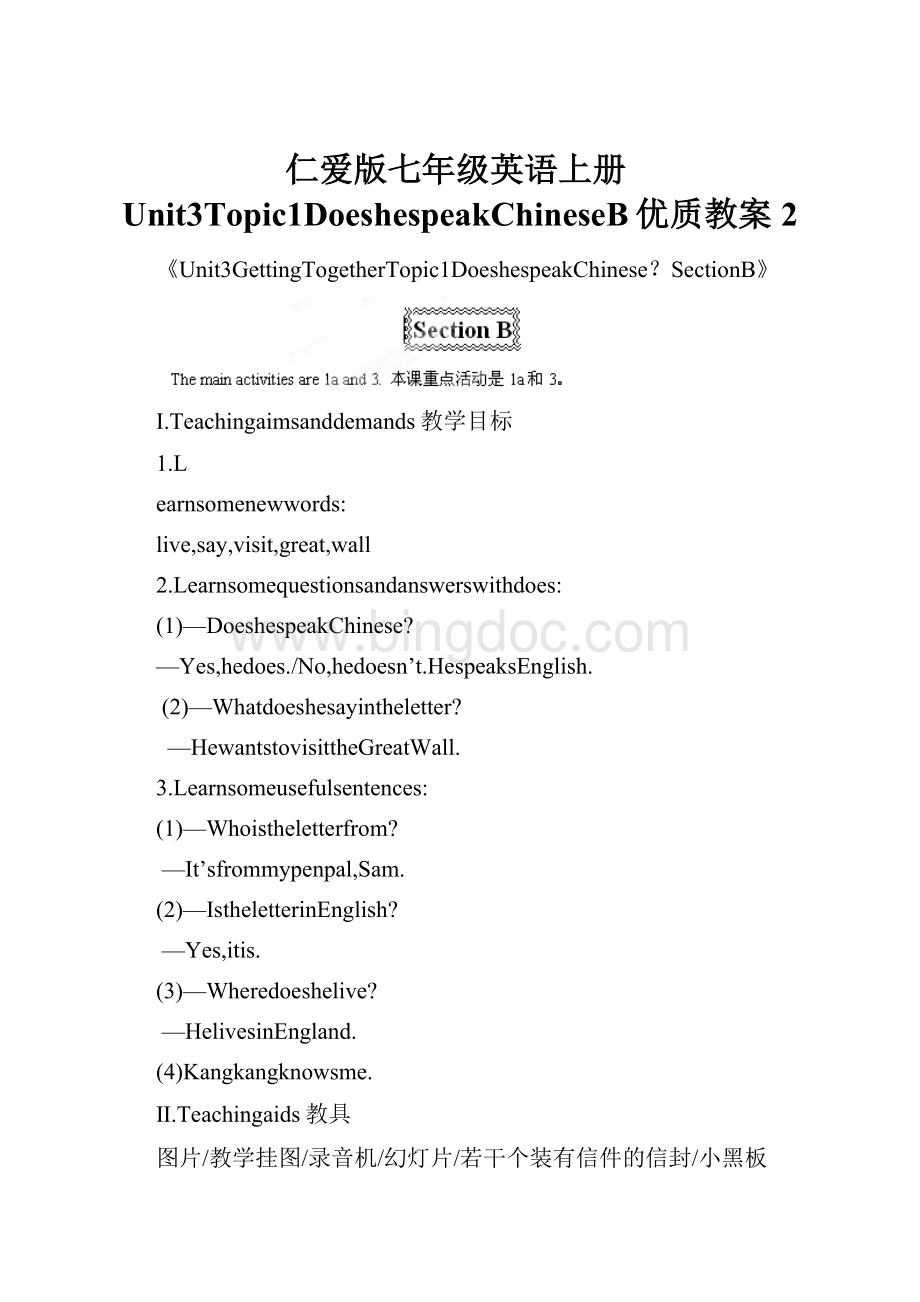仁爱版七年级英语上册Unit3Topic1DoeshespeakChineseB优质教案2.docx
《仁爱版七年级英语上册Unit3Topic1DoeshespeakChineseB优质教案2.docx》由会员分享,可在线阅读,更多相关《仁爱版七年级英语上册Unit3Topic1DoeshespeakChineseB优质教案2.docx(10页珍藏版)》请在冰点文库上搜索。

仁爱版七年级英语上册Unit3Topic1DoeshespeakChineseB优质教案2
《Unit3GettingTogetherTopic1DoeshespeakChinese?
SectionB》
Ⅰ.Teachingaimsanddemands教学目标
1.L
earnsomenewwords:
live,say,visit,great,wall
2.Learnsomequestionsandanswerswithdoes:
(1)—DoeshespeakChinese?
—Yes,hedoes./No,hedoesn’t.HespeaksEnglish.
(2)—Whatdoeshesayintheletter?
—HewantstovisittheGreatWall.
3.Learnsomeusefulsentences:
(1)—Whoistheletterfrom?
—It’sfrommypenpal,Sam.
(2)—IstheletterinEnglish?
—Yes,itis.
(3)—Wheredoeshelive?
—HelivesinEngland.
(4)Kangkangknowsme.
Ⅱ.Teachingaids教具
图片/教学挂图/录音机/幻灯片/若干个装有信件的信封/小黑板
Ⅲ.Five-fingerTeachingPlan五指教学方案
Step1Review第一步复习(时间:
10分钟)
以问题为线索,引出单词和话题,培养学生的语言表达能力。
1.(检查作业。
教师请学生登台表演上节课的家庭作业。
)
T:
Now,I’llcheckyourhomework.S1、S2,please,cometothefrontandperformyourdialog.
2.(师生对话。
引入并运用China和Chinese。
)
T:
IcomefromChina.IamChinese.
Ss:
WecomefromChina.We’reChinese.
(教师提问一名学生。
)
T:
Wheredoyoucomefrom,S3?
S3:
IcomefromChina.
T:
DoyouspeakChinese?
S3:
Yes,Ido.
(学生两人一组互相问答。
)
(教师可以穿插讲解“吉鸿昌爱国”的故事,培养学生的爱国主义情感,增强“爱国意识”。
解放前,外国人都看不起我们中国人,说我们是“东亚病夫”。
当时在国外,有的中国人都不敢承认自己是中国人,但吉鸿昌到国外后,勇敢地对外国人说自己是中国人,并且自制了一个纸牌挂在胸前,上面用英语写道:
IamChinese!
)
3.(教师出示一幅长城的图片。
)
T:
CanyousayitinEnglish?
S4:
Yes,theGreatWall.(教师帮助回答。
)
T:
Whereisit?
S4:
It’sinChina.
T
:
DoyouliveinChina?
S4:
Yes,Ido.(教师帮助回答。
)
T:
IsChinagreat?
S4:
Yes,itis.
(板书并要求学生掌握say,wall,live,great;理解theGreatWall。
)
say,wall,theGreatWall,live,great
4.(教师接着出示第二幅图片。
)
T:
DoyouliketheGreatWall?
S5:
Yes,Ido.
T:
DoyouwanttovisittheGreatWall?
S5:
Yes,Ido.
(板书并要求学生掌握。
)
visit
(教师让学生两人一组,运用所呈现的生词编对话。
)
5.(教师介绍S5的情况,然后让学生根据介绍回答问题。
)
T:
S5livesinChina.He/ShelikestheGreatWall.He/ShewantstovisittheGreatWall.
(教师请另一位学生,根据这段话回答问题。
)
T:
WheredoesS5live?
S6:
He/ShelivesinChina.
T:
Doeshe/sheliketheGreatWall?
S6:
Yes,he/shedoes.
T:
Doeshe/shewanttovisittheGreatWall?
S6:
Yes,he/shedoes.
(通过以上活动导入1a。
)
Step2Presentation第二步
呈现(时间:
8分钟)
根据1a的教学挂图回答问题,练习本课基本句型,引出对话内容。
培养学生听说能力和阅读能力。
1.(教师呈现1a的教学挂图,与学生谈论。
)
T:
Whoarethey?
Ss:
TheyareJaneandKangkang.
T:
DoesKangkanghavearoundface?
Ss:
Yes,hedoes.
T:
DoesJanehavelonghair?
Ss:
Yes,shedoes.
T:
DoesKangkanghavealetterinhishand?
Ss:
Yes,hedoes.
T:
Whoistheletterfrom?
Let’slistentothetapeandthenfindtheanswer.
(教师播放1a录音,让学生听并回答Whoistheletterfrom?
)
(板书)
Whoistheletterfrom?
(核对答案。
)
2.(教师再播放一遍1a录音,要求学生根据1a判断正(T)误(F)。
)
(幻灯片展示试题。
)
(1)SamisKangkang’spenpal.()
(2)SamspeaksChinese.()
(3)
Samsayshewantstovi
sittheGreatWall.()
(核对答案。
)
3.(分角色朗读对话,进一步理解对话内容。
教师板书重点句子和短语并解释,要求掌握。
)
(1)speak+语言名称=say…in+语言名称
(2)livein…
(3)intheletter
(4)—Whatdoeshesayintheletter?
—HewantstovisittheGreatWall.
4.(根据1a内容,教师随机提问学生,并核对答案,完成1a。
)
T:
Whoistheletterfrom?
S1:
It’sfromSam.
T:
IsKangkangSam’spenpal?
S2:
Yes,heis.
T:
DoesSamspeakChinese?
S3:
No,hedoesn’t.
T:
DoesheliveinEngland?
S4:
Yes,hedoes.
…
5.(双人小组活动。
学生独自完成1b,然后同桌分角色表演1b对话。
)
Step3Consolidation第三步巩固(时间:
7分钟)
模仿1a,1b编对话,让学生学以致用,培养学生综合运用语言的能力。
1.(教师利用幻灯片呈现习题,要求学生根据对话内容填写所缺单词,每空一词。
)
S1:
What’sthatinEnglish?
S2:
It’saletter.
S1:
Isityours?
S2:
Yes,it’smine.
S1:
Whoisitfrom?
S2:
It’sfrommypenpal,Tom.
S1:
DoeshespeakChinese?
S2:
No,hedoesn’t.HespeaksEnglish.
S1:
Whatdoeshesayinthelett
er?
S2:
HewantstovisitChina.
(画线部分是要填的词
。
)
2.(教师把事先准备好的信封发给各小组,然后根据信封及信的内容两人一组进行对话练习。
对话应包括以下句型:
)
T:
Let’smakeadialoginpairswiththefollowingsentences.
(1)—Whoistheletterfrom?
—It’sfrom…
(2)—Wheredoeshe/shecomefrom?
—He/Shecomesfrom…
(3)—Whatdoeshe/shesayinthe
letter?
—He/Shewantsto
…
(教师挑选两组学生表演,掌声鼓励。
)
3.(双人活动。
同桌对话,了解对方笔友的情况。
要求运用以下幻灯片中的句型。
)
(1)Isitaboyoragirl?
(2)It’saboy/girl.
(3)Doeshe/shecomefrom…?
(4)Yes,…does./No,…doesn’t.
(5)Doeshe/sheliveinChina?
(6)Yes,…does./No,…doesn’t.
(7)Doeshe/shelikeChina?
(8)Yes,…does./No,…doesn’t.
Step4Practice第四步练习(时间:
10分钟)
在不同情景中练习目标语言,展开任务型活动,学以致用,锻炼学生合作能力。
1.(教师播放2录音,学生听后回答问题,完成2,核对答案。
)
T:
Listentothetapeof2andanswerthefollowingquestions.Thenchecktheanswers.
2.(教师将2的听
力材料用幻灯片
或小黑板展示出来,然后让学生两人一组根据内容编对话。
)
T:
Pleaseworkinpairstomakeadialogaccordingtothesentencesontheblackboard.Andthenactitout.
Example:
S1:
Doyouhaveagoodfriend?
S2:
Yes,Ido.
S1:
Couldyoupleasetellmehername?
S2:
Sure.HernameisLucy.
S1:
Wheredoesshecomefrom?
S2:
ShecomesfromEngland.
S1:
Wheredoesshelivenow?
S2:
ShelivesinChina.
S1:
DoesshelikeChina?
S2:
Yes,shedoes.ShelikesChinaverymuch.
S1:
DoesshespeakChinese?
S2:
No,shedoesn’t.ShespeaksEnglish.
…
3.(教师引导学生观察3中的句子,并归纳句子的规律——当主语是第三人称单数时,谓语动词原形后加(e)s。
)
T:
Pleaseobservethesentencesin3andfindouttherulesofverbschanginginthethirdsinglepersonalpronouns.
(板书下列内容并解释。
)
Kangkang→knows
He→lives/helps/wants
She→speaks
…
4.(教师播放3录音,让学生跟读,练习(e)s的读音。
完成3。
)
Step5Project第五步综合探究活动(时间:
10分钟)
通过练习动词第三人称单数的读音规则及其一般疑问句的问答,培养学生观察探究能力。
1.(教师鼓励学生探究“动词第三人称单数的读音”,并总结。
)
(小黑板展示下列内容。
)
lives,speaks,spells,phones,knows,does,hands,comes,looks,gives,likes,dresses,
thinks,guesses,finds,helps,tells,meets,wants,visits
(教师先领着学生读一遍,要求学生边读边注意词尾s的发音。
接着,教师将学生分组,并为各小组命名,如先锋队、雄鹰队、立志队等,引发学生的兴趣。
然后,为各小组明确共同目标,即归纳出-s在动词后的读音规律。
每个成员针对词尾s的不同读音进行观察,发现规律并进行归纳总结。
接下来,组内成员互相补充,力图达到全面、准确。
各组选出小组发言人进行汇报,其他各组学生均可补充发言。
最后由教师总结,再按读音将幻灯片上的词分类。
)
2.(问答接龙。
参照4,教师让学生八人一组,第一位同学用Doyou…?
向第二位
同学提问,第二位同学用Yes,Ido./No,Idon’t.回答,并用Doeshe/she…?
向第三位同学提问,而第三位同学又用Yes,he/shedoes./No,he/shedoesn’t.回答并向第四位同学提问。
以此类推,每位同学提问时要用到盒子里不同动词,完成4。
)
Example:
S1:
Doyouhavearuler?
S2:
Yes,Ido./No,Idon’t.DoesyourfriendlikeChina?
S3:
Yes,…does./No,…doesn’t.Does…want…?
…
3.Homework:
(1)根据1a内容写一段话。
(四十个单词左右)
Example:
ThisisaletterinEnglish.It’sfromSam.SamisKangkang’spenpal.KangkanglivesinChina.SamlivesinEngland.InSam’sletter,hesaysh
ewantstovisittheGreatWall.
(2)制作卡片,把人称代词的主格宾格分别写在卡片上。
板书设计:
DoeshespeakChinese?
SectionB
say…inEnglish—Whoistheletterfrom?
=speakEnglish—It’sfrom…
livein…—DoeshespeakChinese?
theGreatWall—Yes,hedoes./No,hedoesn’t.
wanttovisit…—Whatdoeshesayintheletter?
—HewantstovisittheGreatWall.